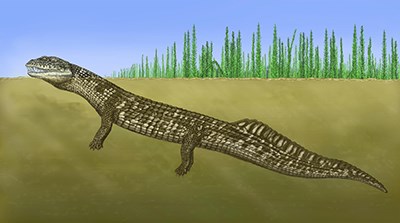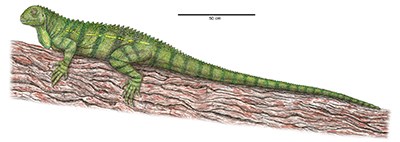Drepanosaurs, tanystropheids, and VancleaveaDrepanosaurs are bizarre reptiles that are generally small and are known from exquisite specimens from the Triassic limestone quarries in Europe. They may have behaved much like modern chameleons or squirrels; they generally had large, hooked claws on their hands and prehensile, grasping tails. At the park, drepanosaurs are known from these claws and their vertebrae. Tanystropheids are small reptiles that tend to have extraordinarily long necks which are longer than the rest of the body. Vertebrae from these animals are very recognizable, and have only been recognized in the park since 2013. 
NPS Vancleavea Vancleavea was named after Phillip Van Cleave, a former Chief Naturalist at Petrified Forest who collected the fragmentary postcranial remains of this small reptile in the early 1960s.
Lepidosaurs
What we know about the origins of early lizards and snakes comes from Triassic microvertebrate fossils. Because many of these animals were so small and delicate, most of the lepidosaurs from Petrified Forest are recognized through their teeth, which are implanted on the insides or tops of the upper and lower jaws. Looking for lizard jaws is tedious work; paleontologists wash bags of rock through sieves of various sizes before spending hours picking the fossils from the sediment using microscopes of high magnification. 
NPS Allokotosaurs Members of this diverse reptile group include Trilophosaurus and Azendohsaurus. Trilophosaurus is incredibly abundant from the Triassic-age rocks in western Texas. It was an herbivore up to 8.2 feet (2.5 meters) long. It had a short, unusually heavily built skull, equipped with massive, broad, flattened cheek teeth with sharp, shearing surfaces for cutting through tough plant material. The name "Trilophosaurus" means "three-ridge reptile" and refers to its strange teeth that have three tall crests. Azendohsaurus is known from what is now Madagascar, but a closely related animal once lived at Petrified Forest, as well.
NPS/Jeff Martz Phytosaur fossils are some of the most abundant vertebrate fossils in the park. These long-snouted reptiles are closely related to archosaurs. They look very much like the modern crocodylians, but there are several things that differentiate phytosaurs from crocodylians. First, the nostrils of phytosaurs are located high up on the skull, almost between the eyes! Second, phytosaurs do not have a complete bony roof over the mouth. Third, phytosaurs have a paired row of armor scutes down their back, unlike crocodylians that have multiple rows. Two of the phytosaurs that you would encounter at Petrified Forest in the Triassic are named Smilosuchus and Machaeroprosopus.

NPS Archosaurs The "ruling reptiles" of Archosauria rule the fossil record at Petrified Forest. More information can be found on the Pseudosuchian and Orthinodiran archosaur pages. Archosaurs can be differentiated from other reptiles, and from each other, by their ankle structure. 
NPS/Jeff Martz |
Last updated: June 13, 2024
